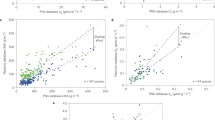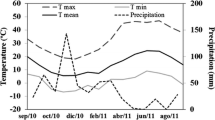Abstract
The chapter by Chazdon et al. (Chapter 1) concerned relationships between the light environment and the photosynthetic response of tropical forest plants. This chapter builds upon these relationships by exploring the dependence of total plant photosynthesis upon orientation and position of photosynthetic surfaces and characteristics of the photosynthetic response. A simple two-dimensional model of an individual plant or plant stand will be used to explore the dependence of total plant photosynthetic rate on plant geometry, particularly with respect to two common characteristics of tropical forest plants and their environment, heliotropism and high solar elevation angles.
Access this chapter
Tax calculation will be finalised at checkout
Purchases are for personal use only
Preview
Unable to display preview. Download preview PDF.
Similar content being viewed by others
References
Chazdon, R. L. (1985) Leaf display, canopy structure, and light interception of two understory palm species. American Journal of Botany, 72, 1493–1502.
Darwin, C. R. (1881) The Power of Movement in Plants. D. Appleton, New York.
Diggle P. J., Fisher, N. I. (1985) SPHERE: A contouring program for spherical data. Computers and Geosciences, 11, 725–766.
Ehleringer, J. R. & Forseth, I. N. (1980) Solar tracking by plants. Science 210, 1094–1098.
Farquhar, G. D. (1989) Models of integrated photosynthesis of cells and leaves. Philosophical Transactions of the Royal Society B (London), 323, 357–367.
Fisher, J. B. (1986) Branching patterns and angles in trees. On the Economy of Plant Form and Function, (ed. T. J. Givnish,), Cambridge University Press, Cambridge, pp 493 – 523.
Fisher, J. B. & Honda, H. (1979) Ratio of tree branch lengths: the equitable distribution of leaf clusters on branches. Proceedings of the National Academy of Sciences USA, 76, 3875–3879.
Geller, G. N. & Nobel, P. S. (1984) Cactus ribs: Influence on PAR interception and update. Photosynthetica, 18, 482–494.
Geller, G. N. & Nobel, P. S. (1986) Branching patterns of columnar cacti: Influences on PAR interception and update. American Journal of Botany, 73, 1192–1200.
Gutschick, V. P. & Wiegel, F. W. (1988) Optimizing the canopy photosynthetic rate by patterns of investment in specific leaf mass. American Naturalist, 132, 67–86.
Herbert, T. J. (1984) Axial rotation of Erythrina herbacea leaflets. America Journal of Botany, 71, 76–79.
Herbert, T. J. (1989) A model of daily leaf movement in relation to the radiation regime, in Advances in Legume Biology, (eds Stirton, C.H., Zarucchi, J. L.) Monographs in Systematic Botany from the Missouri Botanical Garden, 29 pp. 629–643.
Herbert, T.J. (1991) Statistical variation in interception of the direct solar beam by top canopy layers. Ecology 72, 17–22.
Herbert, T.J. (1992a) Geometry of heliotropic and nyctinastic leaf movements. American Journal of Botany, 79, 547–550.
Herbert, T. J. (1992b) Random wind-induced leaf orientation — Effect upon maximization of whole plant photosynthesis. Photosynthetica, 26, 601–607.
Herbert, T. J. & Larsen, P. B. (1985) Leaf movement in Calathea lutea (Marantaceae). Oecologia, 67, 238–243.
Herbert, T. J. & Nilson, T. (1991) A model of variance of photosynthesis between leaves and maximization of whole plant photosynthesis. Photosynthetica, 25,597–606.
Honda, H. E., Fisher, J. B. (1978) Tree branch angle: Maximizing effective leaf area. Science 199, 888–890.
Horn, H. S. (1971) The Adaptive Geometry of Trees. Princeton University Press, Princeton.
Kawashima, R. (1969a) Studies on the leaf orientation-adjusting movement in soybean plants. I. The leaf orientation-adjusting movement and light intensity on leaf surface. Proceedings of the Crop Science Society of Japan, 38,718–729.
Kawashima, R. (1969b) Studies on the leaf orientation-adjusting movement in soybean plants. II. Fundamental pattern of the leaf orientation-adjusting movement and its significance for dry matter production. Proceedings of the Crop Science Society of Japan, 38, 730–742.
Kuroiwa, S. (1970) Total photosynthesis of a foliage in relation to inclination of leaves. Prediction and Measurement of Photosynthetic Productivity. PVDOC, Wageningen, pp. 79–89.
Laisk, A., Eichelmann, H. (1989) Towards understanding oscillations: a Mathematical model of the biochemistry of photosynthesis. Philosophical Transactions of the Royal Society B (London), 323, 369–384.
Laisk, A. & Walker, D. A. (1989) A mathematical model of electron transport. Thermodynamic necessity for photosystem II regulation: ‘Light Stomata’. Philosophical Transactions of the Royal Society B (London), 237, 417–444.
Lieth, J. R. & Reynolds, J. F. (1987) The nonrectangular hyperbola as a photosynthetic light response model: geometrical interpretation and estimation of the parameter Θ. Photosynthetica, 21, 363 – 366.
Myneni, R. B. & Impens, I. (1985a) A procedural approach for studying the radiation regime of infinite and truncated foliage spaces. Part I. Theoretical considerations. Agricultural and Forest Meteorology, 33, 327–337.
Myneni, R. B. & Impens, I. (1985b) A procedural approach for studying the radiation regime of infinite and truncated foliage spaces. Part II. Experimental results and discussion. Agricultural and Forest Meteorology, 34, 3–16.
Myneni, R. B., Asrar, G., Kanemasu, E. T., Lawlor, D. J. & Impens, I. (1986a) Canopy architecture, irradiance distribution on leaf surfaces and consequent photosynthetic efficiencies in heterogeneous plant canopies. Part I. Theoretical considerations. Agricultural and Forest Meteorology, 37, 189–204.
Myneni, R. B., Asrar, G., Wall, G. W., Kanemasu E. T. & Impens, I. (1986b) Canopy architecture, irradiance distribution on leaf surfaces and consequent photosynthetic efficiencies in heterogeneous plant canopies. Part II. Results and discussion. Agricultural and Forest Meteorology, 37, 205 –218.
Niklas, K. J. & Kerchner, V. (1984) Mechanical and photosynthetic constraints on the evolution of plant shape. Paleobiology 10, 79–101.
Nilson, T. (1968) On the optimum geometrical arrangement of foliage in the plant cover. Investigations of Atmospheric Physics (Tartu), 11, 112–146.
Oikawa, T. (1977a) Light regime in relation to plant population geometry II. Light penetration in a square-planted population. Botanical Magazine (Tokyo), 90, 11–22.
Oikawa, T. (1977b) Light regime in relation to plant population geometry III. Ecological implications of a square-planted population from the viewpoint of utilization efficiency of solar energy. Botanical Magazine (Tokyo), 90, 301–311.
Oikawa, T. & Saeki, T. (1977) Light regime in relation to plant population geometry I. A Monte Carlo simulation of light microclimates within a random distribution foliage. Botanical Magazine (Tokyo), 90, 1 –10.
Pearcy, R.W. & Calkin, H. W. (1983) Carbon dioxide exchange of C3 and C4 tree species in the understory of a Hawaiian forest. Oecologia, 58, 26 – 32.
Richards, P. W. (1966) The Tropical Rainforest. Cambridge Univ. Press, Cambridge, p. 89.
Shell, G. S. G., Lang, A. R. G. & Sale, P. J. M. (1974) Quantitative measures of leaf orientation and heliotropic response in sunflower, bean, pepper and cucumber. Agricultural Meteorology, 13, 25–37.
Wainwright, G. M. (1977) Sun-tracking and related leaf movements in a desert lupine (Lupinus arizonicus). American Journal of Botany, 64, 1032–1041.
Editor information
Editors and Affiliations
Rights and permissions
Copyright information
© 1996 Chapman & Hall
About this chapter
Cite this chapter
Herbert, T.J. (1996). On the Relationship of Plant Geometry to Photosynthetic Response. In: Mulkey, S.S., Chazdon, R.L., Smith, A.P. (eds) Tropical Forest Plant Ecophysiology. Springer, Boston, MA. https://doi.org/10.1007/978-1-4613-1163-8_5
Download citation
DOI: https://doi.org/10.1007/978-1-4613-1163-8_5
Publisher Name: Springer, Boston, MA
Print ISBN: 978-1-4612-8493-2
Online ISBN: 978-1-4613-1163-8
eBook Packages: Springer Book Archive




